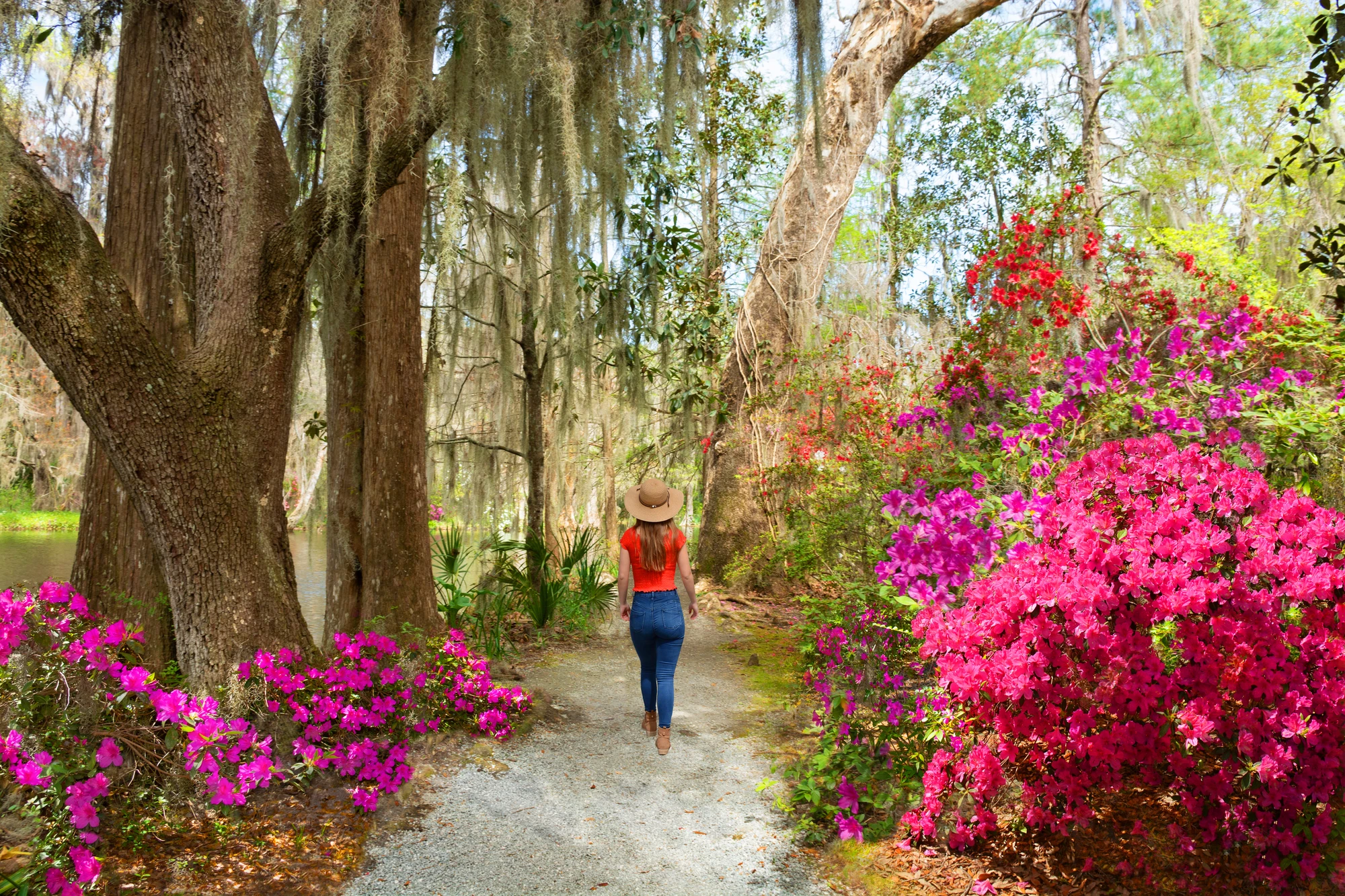Magnolia’s Quiet Revolt: Walking the Historic Gardens of Charleston’s Lowcountry
A stroll through Charleston’s oldest public gardens, where history, habitat, and horticulture converge
Photo by Margaret.Wiktor
Shutterstock (ID: 1705611781)
You arrive beneath a cathedral of live oaks—massive limbs draped in Spanish moss that sways like a slow, deliberate breath. The path underfoot is soft with leaf litter and punctuated by blastings of azalea color: reds, pinks, and an almost electric fuchsia that seems to glow against the deep green. Somewhere ahead a wading bird lifts from the marsh with a pause and a hush of wings. This is Magnolia Plantation & Gardens, a place where history and habitat meet in the humid, tidal edge of Charleston’s Ashley River.
Trail Wisdom
Start early
Arrive at opening to enjoy cooler air, better bird activity, and fewer crowds—especially during spring azalea season.
Wear sturdy walking shoes
Trails and boardwalks can be uneven or muddy after rain—comfortable, supportive footwear prevents sore feet.
Bring insect protection
Mosquitoes and ticks are common near marshes and the swamp garden—use repellent and check for ticks afterward.
Reserve tours in advance
Tram and boat tours have limited capacity; booking ahead guarantees a spot during peak season.
Local Knowledge
Hidden Gems
- •Audubon Swamp Garden boardwalk—quiet marshland and old cypress groves
- •Ashley River boat excursions—dawn trips often reveal herons and river otters
Wildlife
Great blue heron, White-tailed deer
Conservation Note
The gardens practice habitat stewardship—restoring native plantings, managing invasive species, and educating visitors about the area’s tidal ecosystems.
Magnolia was established by the Drayton family in the 17th century and evolved into one of the oldest public gardens in the United States, reflecting both landscape design and Lowcountry plantation history.
Seasonal Guide
spring
Best for: Azalea and camellia blooms, Bird migration and nesting
Challenges: Higher visitor numbers, Variable spring showers
Spring is peak floral season—brilliant azalea displays and active birdlife—but expect crowds and occasional rain.
summer
Best for: Lush foliage, Early-morning wildlife viewing
Challenges: High heat and humidity, Insect activity (mosquitoes)
Summer shows the garden in full green growth; cooler early-morning visits are best to avoid heat and bugs.
fall
Best for: Quieter trails, Autumnal structure and late-blooming plants
Challenges: Shorter daylight, Occasional hurricane-season storms
Fall offers smaller crowds and a different palette—more structure and seedheads—while weather can be changeable.
winter
Best for: Crisp light and architectural plant forms, Holiday events (when scheduled)
Challenges: Fewer blooms, Cooler temperatures
Winter is quieter with fewer flowers but excellent light for photography and clearer views of garden structure.
Photographer's Notes
What to Bring
Comfortable walking shoesEssential
Support and traction for mixed surfaces, boardwalks, and soft paths.
Insect repellentEssential
Protects against mosquitoes and ticks near the swamp and marsh areas.
Binoculars
Helps spot wading birds, herons, and marsh wildlife from a distance.
Sun protection (hat & sunscreen)Essential
Necessary for exposed garden beds and boat tours under strong sun.
Common Questions
How long should I plan for a visit?
Plan 1–3 hours to explore the main gardens and boardwalk; add time if you take the tram, boat tour, or house tour.
Are there guided tours available?
Yes—narrated trams, guided garden walks, and boat tours run regularly; check the schedule and reserve spots when available.
Is Magnolia wheelchair accessible?
Many of the main garden paths, the tram, and portions of the swamp boardwalk are accessible, but some areas have uneven surfaces—call ahead for specifics.
Can I bring my dog?
Pets are generally not allowed in the gardens except for service animals; verify current policies before bringing a pet.
What’s the best time of day to visit?
Early morning offers cooler temperatures and better wildlife viewing; late afternoon provides softer light for photos and fewer people.
Is there parking and are there fees?
Onsite parking is available; Magnolia charges an admission fee that helps fund maintenance and conservation—check the official site for current rates.
What to Pack
Comfortable walking shoes for mixed surfaces; insect repellent to deter mosquitoes and ticks; sun protection (hat and sunscreen) for exposed beds and boat tours; binoculars to watch marsh birds and wildlife from a distance.
Did You Know
Magnolia Plantation & Gardens was established in the 17th century by the Drayton family and is recognized as one of the oldest public gardens in the United States.
Quick Travel Tips
1) Arrive at opening to avoid crowds; 2) Reserve tram and boat tours in advance; 3) Bring cash or card for admission and plant shop purchases; 4) Check the weather—tides and storms can affect boat tours.
Local Flavor
Pair a garden visit with Lowcountry cuisine in Charleston—think shrimp and grits or she-crab soup—and seek out local markets for preserves and coastal produce; the area’s Gullah culture also informs much of the region’s culinary and craft traditions.
Logistics Snapshot
Address: Magnolia Plantation & Gardens, Ashley River Rd, Charleston, SC; Hours vary seasonally—early arrival recommended; Admission required—check official site for current pricing; Onsite parking available; Guided tram and boat tours operate on set schedules—reserve when possible.
Sustainability Note
Stay on designated paths, avoid feeding wildlife, and support the garden’s conservation programs by purchasing plants or donating—these steps help protect fragile marsh habitats and the garden’s biodiversity.

